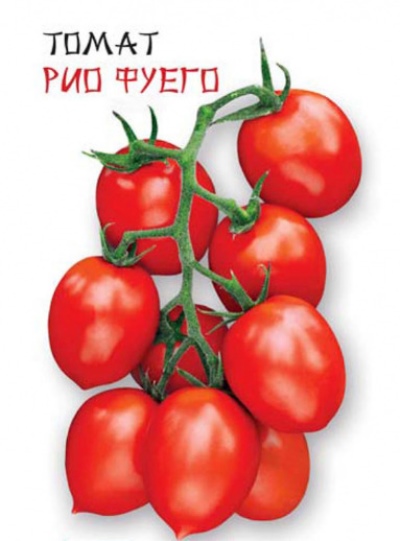
- Authors: Italy
- Name synonyms: Rio Fuego
- Category: hybrid
- Growth type: determinant
- Appointment: fresh consumption, for pickling and canning, for whole-fruit canning, for drying and drying
- Ripening period: early
- Ripening time, days: 98-110
- Growing conditions: for open ground, for film greenhouses
- Marketability: high
- Transportability: good
When growing for sale tomatoes, which have a high marketability, it is worthwhile to study the Rio Fuego variety in more detail.
Description of the variety
The variety was bred in Italy, it is a hybrid with a determinant type of growth. Its fruits are good not only fresh, they are suitable for canning and even drying.
Rio Fuego is grown in film greenhouses and open field. The bushes are medium-sized, maximum 90 cm, characterized by strong foliage.
The main qualities of the fruit
Ripe Rio Fuego tomatoes with an intense red hue. The shape of tomatoes is oval, weight is a maximum of 130 grams. A dense pulp is hidden inside. The fruits of this tomato lie well after harvest, if the necessary conditions are created.
Taste characteristics
Those who grow this variety, as well as other tomato lovers, note that Rio Fuego has a tomato, pleasant taste.
Ripening and fruiting
The described variety is early, after 110 days you can harvest.
Yield
Rio Fuego's yield figures are quite high. So, from one square meter, you can collect 7-8 kilograms of fruits, respectively - 60 t / ha, and up to 3 kilograms of tomatoes from a bush.
The timing of planting seedlings and planting in the ground
Rio Fuego seeds are sown for seedlings from the beginning of March. At the moment when 4-5 true leaves are formed, they are transferred to the ground, usually 35 to 45 days pass.

Growing tomato seedlings is an extremely important process, because it largely depends on whether the gardener will be able to harvest at all. All aspects must be taken into account, from seedbed preparation to planting in the ground.
Landing scheme
The planting scheme is standard - 3-4 plants per m2.

Growing and care
If not dived seedlings of Rio Fuego are grown, the seedlings are placed at a distance of 6-8 cm. After 10-15 days, the plants are sprinkled with fresh soil with a layer of 2 cm. If necessary, the addition is repeated (after 10-12 days). Young plants are first watered with warm water at the rate of 5 liters per square meter, and when growing up, the water rate is increased to 10-15 liters.
After picking the seedlings (after 7-10 days), the first feeding is carried out. 40 g of superphosphate, 5 g of ammonium nitrate and 12 g of potassium sulfate are introduced under the greenhouse frame. The second and third feeding is carried out 10 days after the previous time. Fertilizer doses are doubled compared to the first time.
To improve the quality of seedlings, as well as to prevent their overgrowth, a 0.2% solution of chlorocholine chloride ("Tur") is used. Water the Rio Fuego seedlings in the 3-4 phase of this leaf. The solution of the drug is poured with clean water at the rate of 1 liter per 1 m2. The second time the seedlings are treated in the same way, 7 days after the first treatment.
Mass planting of Rio Fuego tomatoes in open ground can begin when warming in spring comes, and the threat of frost return has passed on the soil surface.
On the day of planting, Rio Fuego seedlings are watered to better preserve the roots. During this time, it is sorted by size and quality. Damaged by pests and affected by diseases, as well as broken ones are discarded, the underdeveloped one is left for growing. If it is not aligned in height, first choose a larger one, and then a smaller one. Plants of different size develop unevenly, which leads to significant yield losses.
In order to have early production, Rio Fuego tomato is planted on a part of the area 15-20 days earlier. To do this, choose areas on the southern slopes with light soils, protected from cold winds.




A plant needs different micronutrients at each stage of growth. All fertilizers can be divided into two groups: mineral and organic. Folk remedies are often used: iodine, yeast, bird droppings, eggshells.
It is important to observe the rate and period of feeding. This also applies to folk remedies and organic fertilizers.
Disease and pest resistance
This variety is remarkable in that it has good resistance to:
alternaria;
verticillosis;
fusarium wilting.
Resistant to extreme weather conditions
The Rio Fuego tomato is a heat-resistant, drought-resistant, stress-resistant tomato variety. Shelter is necessary when growing in cool regions of our country.



























































































